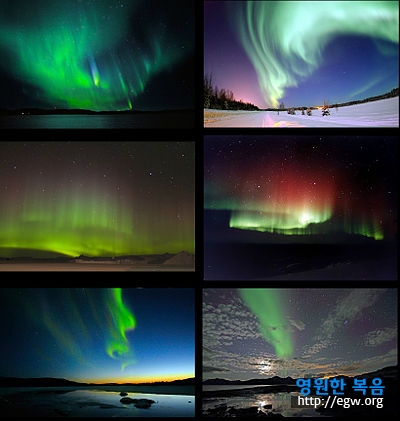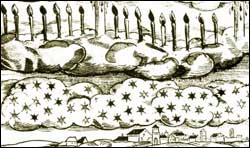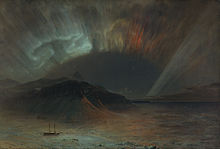Aurora Borealis – “Heavenly Sky Lights”

Aurora Astra not Aurora Borealis seen in China in 2600
BCE [chronology under dispute]
The
oldest known auroral citing was written in 2600 B.C. in China: "Fu-Pao,
the mother of the Yellow Empire Shuan-Yuan, saw strong lightning moving around
the star Su, which belongs to the constellation of Bei-Dou, and the light
illuminated the whole area."
This
is not a case of Aurora Borealis but rather a case of Aurora Astar, just a star
and not the sky.
Greek Explorer Pytheas saw an aurora in the 4th
century BCE
An
aurora was described by the Greek
explorer
Pytheasin
the 4th century BC
(Macleod,
Explorers: Great Tales of Adventure and Endurance, p.21)
Latin author Seneca described some aurora events
“Seneca wrote about auroras in the first book of
his Naturales Quaestiones, classifying
them, for instance as pithaei ('barrel-like'); chasmata ('chasm');
pogoniae ('bearded'); cyparissae ('like cypress
trees'), and describing their manifold colors. He wrote about whether they were
above or below the clouds,
and recalled that under Tiberius, an aurora formed above the port city of Ostia
that was so intense and red that a cohort of the army, stationed nearby for
fire duty, galloped to the rescue.”
Latin author Pliny is presumed to have mentioned
about aurora
It
has been suggested that Pliny the Elder depicted the aurora borealis in
his Natural History, when he refers to trabes,
chasma, 'falling red flames' and 'daylight in the night'.
(Bostock,
J. and Riley, H.T., The Natural History of Pliny: Volume II, London,
Bohn (1855). Accessed online on 4th June 2017 at https://archive.org/stream/naturalhistoryof11855plin#page/62/mode/2up/search/aurora).
This book is very interesting recording strange phenomena on earth and in the
sky in history of his time.
Earliest evidence of an aurora is 1570 sketch in
Scotland.

Early drawing of the
aurora, depicted as candles in the sky, 1570. Credit: Crawford Library, Royal
Observatory, Edinburgh, Scotland.
Aurora Borealis presumably first seen in England in March 1716
Butler
1885 said: “AURORA BOREALIS. This wonderful phenomenon, like earthquakes, has
increased greatly during the last hundred years, both in frequency and
brilliancy. Many have sought to. find a natural cause, but without success.
There is no agreement among the learned in attempting to account for it ; and
it can be said of it as Noah Webster said of the darkening of the sun : "
No satisfactory canes has yet been assigned." We regard it as a sign in
the heavens, in fulfillment of prophecy. HENRY JONES, in " Modern
Phenomena," thus speaks of it :— "The most anciently published
history of this phenomenon which I have yet seen, is contained in a large,
one-volume 8vo. 'Dictionary of Arts and Sciences;' published. in London, about
eighty years ago. This, like others published since, gives a full account of
the first occurrence of this phenomenon at London, in March, 1716, and states
expressly that the oldest inhabitant there at that time had never seen nor
heard of the like before. The writer, after giving some six or eight pages on
the subject, concludes his account by giving a list of writings he had found
concerning it, the oldest of which was a magazine in London for the above year
of 1716."
Aurora
Borealis first seen in the USA 11th of December 1719
Butler
1885 continues: “The following statement is by Dr. J. B. FELT of Salem, Mass.:—
" The aurora borealis was seen for the first time in America, Dec. 11,
1719. It filled our country with great alarm. It was dreaded as being the
precursor of the Judgment fires which were to consume the world. It had a
similar effect in England in 1716."
WILLARD
the historian refers to it as follows :— "A phenomenon, singular at the
time, and not yet satisfactorily explained, alarmed the people of New England
in 1719. This was the aurora borealis, first noticed in this country on the
night of the 17th of December."— Willard's Hist. (II. S.), Ed. 1869, p.
146.”
“The
"New American Cyclopedia" says :— "Prior to the year 1716 it was
considered a great rarity by the inhabitants of Upsal ; and Torfteus, the
historian of Denmark, and an Icelander, writing in 1706, speaks of his
recollection of the time when the meteor (meaning the aurora) was an object of
terror in his native island." The American Home Magazine has the following
" The first aurora seen in this country (in the winter of 1719) was of
this kind ; and it is said the bright light which spread from east to west over
the northern sky shone like a great fire, shooting up its deadly flames.
Sometimes it was of a blood-red color, and was very terrible to look at,
filling the minds of the beholders with terror." Cited from G. I. Butler, Facts for the Times: A collection of
Valuable Historical Extracts on a Great Variety of Subjects of Special Interest
to the Bible Student, from Eminent Authors, Ancient and Modern (Battle
Creek, Michigan: Review and Herald, 1885 (3rd edition), pages 170-171.
Benjamin Franklin in 1740 speculated about the
origin of the Aurora Borealis
In
the 1740s Benjamin Franklin theorized in his paper Aurora
Borealis, Suppositions and Conjectures towards forming an Hypothesis for its
Explanation that an aurora was caused by a concentration of electrical
charge in the polar regions intensified by the snow and moisture in the air:
“May
not then the great quantity of electricity brought into the polar regions by
the clouds, which are condens'd there, and fall in snow, which electricity
would enter the earth, but cannot penetrate the ice; may it not, I say (as a
bottle overcharged) break thro' that low atmosphere and run along in the vacuum
over the air towards the equator, diverging as the degrees of longitude
enlarge, strongly visible where densest, and becoming less visible as it more
diverges; till it finds a passage to the earth in more temperate climates, or
is mingled with the upper air?”
Goodman,
N. (ed.) (1931), The Ingenious
Dr Franklin, p.2, Philadelphia: University of Pennsylvania
Press.
https://en.wikipedia.org/wiki/Aurora#Historical_theories.2C_superstition_and_mythology
Olof Hiorter of Uppsala wrote about the aurora in
1741
“Observations
of the rhythmic movement of compass needles due to the influence of an aurora
were confirmed in the Swedish city of Uppsala
by Anders
Celsius and Olof Hiorter. In 1741, Hiorter was able to link
large magnetic fluctuations with an aurora being observed overhead. This
evidence helped to support their theory that 'magnetic storms' are responsible
for such compass fluctuations.”
Henry Cavendish studying aurora in 1790
“Henry
Cavendish made quantifiable observations of the aurora in 1790. He used a
technique known as triangulation to estimate that the aurora light is produced
around 100-130 km in altitude (about 60 miles above Earth's surface).”
https://www.nasa.gov/mission_pages/themis/auroras/aurora_history.html

Painting by Church in 1865
https://en.wikipedia.org/wiki/Aurora#Historical_theories.2C_superstition_and_mythology
Aurora Australis is the southern
lights and it is not possible to say when it was seen the first time.
There
is an increase in the report of this phenomenon since the earliest times and the Bible says that there will be an increase in strange phenomena in the heavens and skies at the End Time. All these examples before modern times of 1716 were minimal and fractional or even sporadic. Currently they are scenic and overwhelming.
















